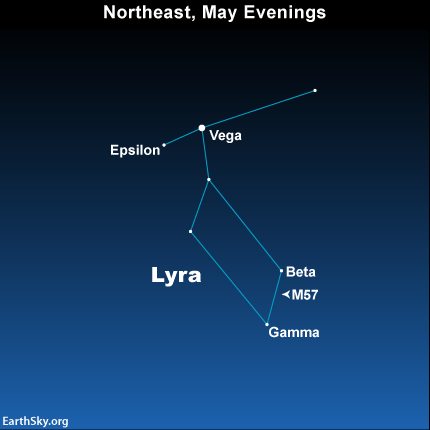Tonight, look eastward during the evening hours, and it’s hard to miss the season’s signature star formation, called the Summer Triangle. Its stars – Vega, Deneb and Altair – are the first three to light up the eastern half of sky after sunset, and their bright and sparkling radiance is even visible from light-polluted cities or on a moonlit night.
Try looking first for the most prominent star in the eastern sky, which is Vega in the constellation Lyra the Harp. Vega is blue-white in color. It’s sometimes called the Harp Star. And many people recognize its constellation, Lyra, as a triangle of stars connected to a parallelogram.
It’s hard to gauge the humongous size of the Summer Triangle by looking at our little chart. A 12-inch ruler, when placed at an arm’s length from your eye, spans the approximate distance from Vega to the star Altair. And an outstretched hand more or less fills the gap between Vega and Deneb.
More than any other month, July is the month of the Summer Triangle. At mid-northern latitudes, the Summer Triangle’s stars – as if a trio of school kids on vacation – stay out from dusk till dawn, dancing amid the stars of our Milky Way galaxy. As our Earth turns tonight, Vega, Deneb and Altair travel westward across the sky. The Summer Triangle shines high overhead in the middle of the night, and sparkles in the west as the rose-colored dawn begins to color the sky.
Our Summer Triangle series also includes:
Part 2: Deneb and its constellation Cygnus
Part 3: Altair and its constellation Aquila
EarthSky astronomy kits are perfect for beginners. Order yours today.
Bottom line: The Summer Triangle consists of 3 bright stars in 3 different constellations. The brightest is Vega in the constellation Lyra.
from EarthSky https://ift.tt/1HAXitg
Tonight, look eastward during the evening hours, and it’s hard to miss the season’s signature star formation, called the Summer Triangle. Its stars – Vega, Deneb and Altair – are the first three to light up the eastern half of sky after sunset, and their bright and sparkling radiance is even visible from light-polluted cities or on a moonlit night.
Try looking first for the most prominent star in the eastern sky, which is Vega in the constellation Lyra the Harp. Vega is blue-white in color. It’s sometimes called the Harp Star. And many people recognize its constellation, Lyra, as a triangle of stars connected to a parallelogram.
It’s hard to gauge the humongous size of the Summer Triangle by looking at our little chart. A 12-inch ruler, when placed at an arm’s length from your eye, spans the approximate distance from Vega to the star Altair. And an outstretched hand more or less fills the gap between Vega and Deneb.
More than any other month, July is the month of the Summer Triangle. At mid-northern latitudes, the Summer Triangle’s stars – as if a trio of school kids on vacation – stay out from dusk till dawn, dancing amid the stars of our Milky Way galaxy. As our Earth turns tonight, Vega, Deneb and Altair travel westward across the sky. The Summer Triangle shines high overhead in the middle of the night, and sparkles in the west as the rose-colored dawn begins to color the sky.
Our Summer Triangle series also includes:
Part 2: Deneb and its constellation Cygnus
Part 3: Altair and its constellation Aquila
EarthSky astronomy kits are perfect for beginners. Order yours today.
Bottom line: The Summer Triangle consists of 3 bright stars in 3 different constellations. The brightest is Vega in the constellation Lyra.
from EarthSky https://ift.tt/1HAXitg


Aucun commentaire:
Enregistrer un commentaire